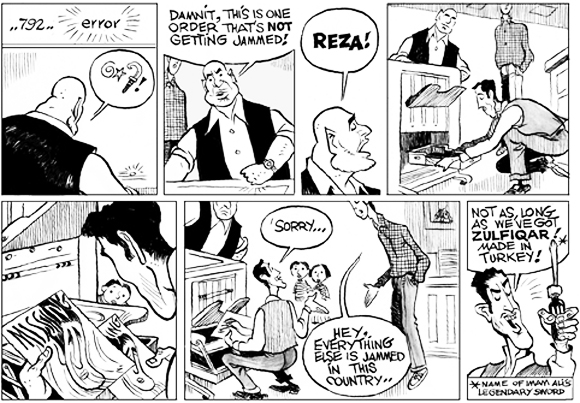| Sun | Mon | Tue | Wed | Thu | Fri | Sat |
|---|---|---|---|---|---|---|
| 1 | 2 | 3 | 4 | 5 | ||
| 6 | 7 | 8 | 9 | 10 | 11 | 12 |
| 13 | 14 | 15 | 16 | 17 | 18 | 19 |
| 20 | 21 | 22 | 23 | 24 | 25 | 26 |
| 27 | 28 | 29 | 30 | 31 |
CATEGORIES
RECENT ENTRIES
BLOG ROLL
Graphic reading at the Reg
A new library exhibit traces the evolution of comics as social criticism.

On three floors of the Reg, “&#$! Graphic Novels as Social Commentary” displays gems from the library’s growing collection of graphic novels and comics. Sarah Wenzel, bibliographer for literatures of Europe and the Americas, helped organize the exhibit and maintains the collection. In a recent interview with UChiBLOGo, she spoke about her passion for books with pictures.
You’re in charge of all the comic books in the library. How did that happen?
I’ve been particularly interested in building a collection of graphic novels, not only in English but other languages. Our current collection represents the cumulative efforts of many people over a long period of time. The great thing about being responsible for a collection is trying to read the tea leaves and figure out what people are going to be interested in over the next five to ten years, and this was one of the things that I thought was going to be really important. Because they can be a little bit ephemeral, I wanted to start collecting, and because there are relatively few places in the U.S. that collect non-English language graphic novels, I particularly wanted to collect those.
You seem to be having fun.
Coming from a very text-based field, it’s really exciting to work with something where images are so important. It’s just a very interesting, eye-opening format.
What’s distinctive about the Regenstein’s collection of graphic novels?
Not a lot of libraries in the U.S. are retro-buying graphic novels; that is, going back and buying the older editions and material. My coup was getting all the issues of Kramer’s Ergot—it’s a graphic-novel magazine, and the first two issues in a small format are almost impossible to find. That took a lot of hunting. Right now for Hillary Chute, a new assistant professor in English, I’m looking for the first issue of Raw, which was the Art Spiegelman–Françoise Mouly collaboration from the 1980s. It’s out of print and hard to get, but I’m keeping my fingers crossed.
Who uses the collection?
Besides the faculty, a lot of students have been using the collection both for pleasure and for research. I could take you up to the stacks and show you what it looks like, but the problem is, the books keep getting checked out. Actually, it’s not a problem at all—it’s a wonderful thing.
Is there a problem with thievery?
Not as much as I was afraid of. We get lists of lost and missing books periodically, and I actually have more trouble with late 18th- and early 19th-century items that people decided they’d rather hold on to than return.
So U of C library patrons return the comic books but keep the Samuel Johnson?
Exactly.
What are some of the highlights of the exhibit on graphic novels?
The display cases begins with antecedents of the graphic novel, including The Yellow Kid, a comic that appeared in the New York World that had a lot of really poignant social commentary. Then we show one of the very first examples of a graphic novel or a comic book, Rodolphe Töpffer’s The Adventures of Mr. Obidiah Oldbuck. He’s Swiss; in Special Collections, we have one of the earliest English-language editions of his work.
What else?
We show comics from the 1930s and ’40s, like The Life and Times of the Shmoo by Al Capp. Then we jump to underground comics from the 1960s to 1980s—and Art Spiegelman, of course—and examples of social commentary around particular themes. We end with the present day and an online comic called Zahra’s Paradise. It’s done anonymously for the safety of the author and the artist, who are Jewish and Iranian, and it’s about the political tension in Iran right now. It’s published online only, although they have a book contract, and in ten languages.
Elizabeth Station
“&#$! Graphic Novels as Social Commentary” begins near the first-floor circulation desk of the Regenstein Library. Wenzel curated the exhibit with Nancy Spiegel, the Reg’s bibliographer for art and cinema, and Emmanuelle Bonnafoux, a PhD candidate in Romance languages and literatures. It runs through the end of winter quarter.
Images courtesy Sarah Wenzel.
September 27, 2010
